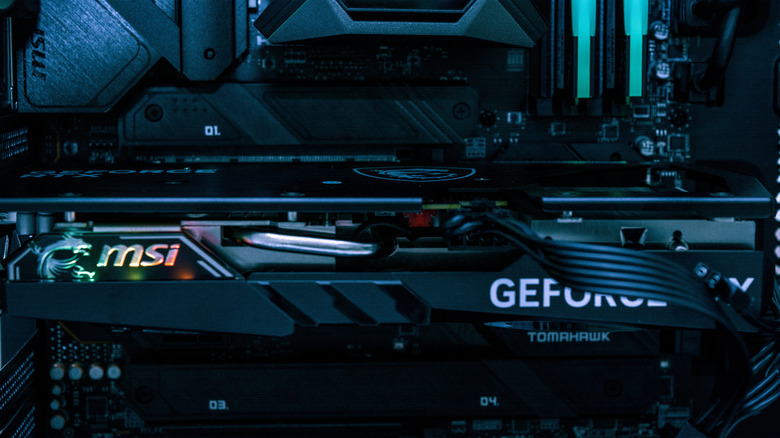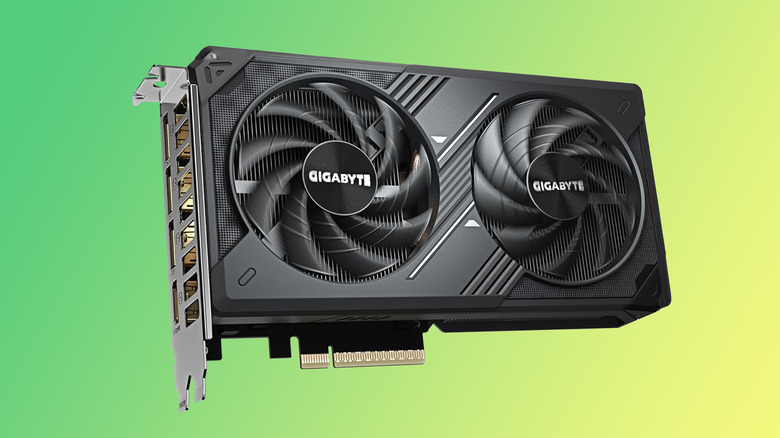AMD Radeon RX 9060 XT Vs. Nvidia GeForce RTX 5060: Which Mainstream GPU Is Better For Gaming?
We may receive a commission on purchases made from links.
While many of us secretly drool over major brand graphic cards like the RTX 5090, the reality is that those GPUs aren't the ones to end up in the average person's PC. It's the mainstream cards from AMD, Nvidia, or Intel, that dominate the charts in gaming PCs. Valve's monthly Steam Hardware Survey can be counted on to have one of Nvidia's midrange cards right at the top. Nvidia's RTX 5060 is the latest addition to a long line of midrange cards, and AMD's RX 9060 XT is now here to compete. But which one is better?
Comparing AMD and Nvidia GPUs is always a bit of an apples-to-oranges kind of situation. The cards are vastly different on an architectural level, so not every specification can be matched up perfectly. With that said, they do have some key differences that might make one or the other better for your particular needs. The RTX 5060 appears in one variant with 8 GB of video RAM (VRAM), the RX 9060 XT can be bought in two different versions: One with 8 GB and one with 16 GB.
The RTX 5060 launched at $299 (a price tag also shared by the RX 9060 XT 8 GB); meanwhile, the 16 GB model of the RX 9060 XT starts at $349. The additional VRAM gives the RX 9060 XT an edge, but it's not that simple — I will explain that below. If you're buying a GPU for a gaming PC, which of these two (or three) cards should you get? As a PC hardware journalist and PC builder with almost 20 years of experience, I will do my best to answer that question for you. Let's start with the specs and benchmarks.
RTX 5060 vs. RX 9060 XT: Specs
Spec-wise, the RTX 5060 and the RX 9060 XT are in a slightly different league, but not massively so. One important spec in a GPU are shader units – Nvidia calls them CUDA cores, and AMD calls them streaming processors (SPs). The way they work means that the two numbers aren't comparable, although they both essentially refer to the same thing. As such, while the RTX 5060 leads with 3,840 CUDA cores, AMD's RX 9060 XT isn't any worse for only featuring 2,048 SPs, so don't let that number fool you. Let's look at the specs that mean the same thing for both cards.
VRAM is a big one. The RTX 5060 maxes out at 8 GB, which is often deemed not to be enough for AAA games in 2025. The RX 9060 XT's 8 GB suffers from the same issue, but the 16 GB version can trade blows with Nvidia's pricier RTX 5060 Ti (which also comes with 16 GB). All three cards share the same 128-bit memory interface, which can be seen as unfortunate for the 9060 XT's 16 GB version, as a wider, 192-bit or 256-bit interface would have given it more bandwidth.
The RX 9060 XT also features lower bandwidth because it uses an older memory standard (GDDR7 vs. GDDR6). This won't affect gameplay in any major way, but you might feel it more at higher resolutions, such as 1440p or 4K. AMD leads in clock speeds at the cost of a slightly higher power draw. Ultimately, these two cards have similar specs, but the extra VRAM on the RX 9060 XT 16 GB version makes it more future-proof.
RTX 5060 vs. RX 9060 XT: Performance
I haven't had the chance to test either of these GPUs yet, but fortunately, I know where to look for benchmarks you can really trust. I will focus on comparing the 8 GB versions of the cards, but I will throw in some context on the 16 GB RX 9060 XT, as that's the card that's considered to be the best value — you won't find it on any list of GPUs with the worst price-to-performance ratio.
TechPowerUp's review of the RX 9060 XT 8 GB reveals that it's, on average, 5% slower than the 16 GB version of the same GPU at 1080p, 4.7% slower at 1440p, and 7.9% slower at 4K. This makes sense — having more memory is crucial at higher resolutions. Meanwhile, compared to the RTX 5060, the RX 9060 XT is actually faster (even with 8 GB VRAM), averaging 3.5% faster at 1080p, 6.7% at 1440p, and a whopping 30% faster at 4K. For added context, the RX 9060 XT is considerably slower than the 8 GB version of Nvidia's RTX 5060 Ti at 1080p, but faster at 4K.
Tom's Hardware tested the 16 GB version of the card and found it trading blows with the RTX 5060 Ti 16 GB at 1080p on medium settings, and falling slightly behind at 1440p on ultra settings. It produced much higher frame rates (fps) than the RTX 5060 in both tests. It's important to note that the RX 9060 XT 8 GB got some criticism from reviewers, with Hardware Unboxed on YouTube straight up calling it "bad." It all comes down to VRAM. Out of all three cards, I recommend buying the RX 9060 XT 16 GB to future-proof your gaming PC for many years to come.
Methodology
To write this article, I relied on several different sources. For specifications, I turned to the official AMD and Nvidia pages. I turned to my expertise as a PC hardware journalist with a decade of experience, as well as a PC builder of nearly 20 years, to give some much-needed context to what these specs mean for you and your graphics card.
For performance benchmarks, I relied on reputable sources, including reviews of the RTX 5060, RTX 5060 Ti, RX 9060 XT 8 GB, and RTX 9060 XT 16 GB. My main sources included XDA Developers, Tom's Hardware, TechPowerUp, and Hardware Unboxed.


